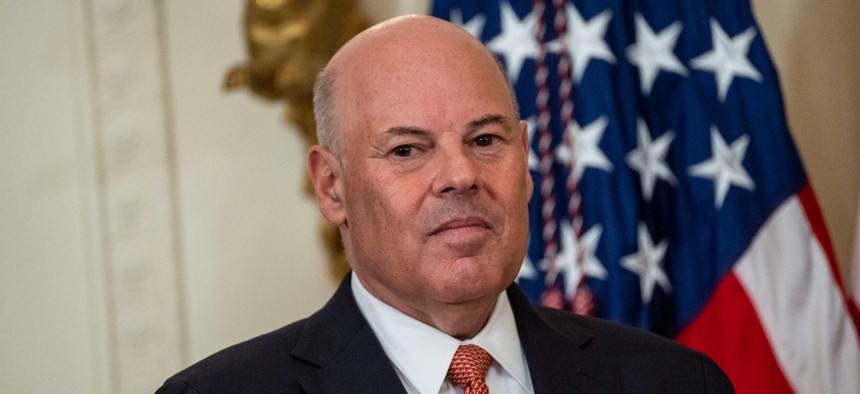
Postmaster General Louis DeJoy attends an event at the White House in June. Kent Nishimura / Los Angeles Times via Getty Images
The Postal Service Didn’t Consider How Its Break-Even Plan Would Impact Specific Demographic Groups
IG otherwise praises USPS for the work it put into crafting its 10-year plan.
The U.S. Postal Service generally supported the assumptions and projections laid out in Postmaster General Louis DeJoy’s 10-year business plan for the agency, according to its inspector general, but failed to research the impact of its changes on specific demographics in its customer base.
USPS said it, unlike the rest of federal government, was under no obligation to conduct such studies, which the inspector general corroborated in a new report examining DeJoy’s plan. The auditors said, however, such analysis could further promote the mailing agency’s mission to provide reliable, universal service and allow it to better understand any “disparate impacts on individual population groups.” The IG also called on the postal management to more transparently publish updates on its performance in realizing each goal of the plan, which it said would better inform both decision making and stakeholders.
DeJoy’s "Delivering for America" plan involves slowing mail delivery, reducing hours at some post offices, consolidating facilities, raising prices and making significant investments in the agency’s workforce and infrastructure to get it on more stable footing. Despite the Postal Service’s regulator and members of its own board criticizing the assumptions underlying parts of the plan, the IG said postal management carefully and comprehensively laid out how it would record, measure and monitor its goals and associated risks. Cost and revenue calculations were reasonable, the auditors said, and management backed up its assumptions and projections. They praised DeJoy and his team for creating key milestones with dates attached to them and for holding weekly meetings to track progress.
The Postal Service has plans to properly validate all the cost savings attributed to its initiatives on a monthly basis, though the IG said it will continue to “evaluate associated risks” with DeJoy’s vision and will conduct audits on specific topics when it deems doing so appropriate.
While USPS examined the impact its changes would have on mail and package volume, it did not look at the effects on specific groups. A Clinton-era executive order and guidance from the Office of Management and Budget direct federal agencies to assess how major changes would affect various groups, but those mandates do not apply to the Postal Service. Management declined to promise to make such assessments, but did agree to consider them. It will make a determination in a year.
In an April report, the IG found areas with more white residents generally experienced better service performance, while areas with more Hispanic residents saw lower performance. The IG in that report similarly noted USPS policies could have disparate impacts on various groups and implored the agency to include demographic data in its analyses.
“If the Postal Service incorporated demographic data into their analysis, management would be better informed about the potential unintended consequences of their decisions,” the IG said. “As Postal Service policies are established nationally and intended to consistently serve the public good, the agency could enhance its processes to consider the impact of its business decisions on the various demographic groups it serves.”
USPS agreed to improve its Delivering for America website to provide more information, though it noted it has already taken steps to do so by providing data to the press and on social media.







